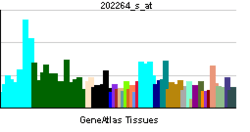TOMM40
| View/Edit Human | View/Edit Mouse |
Translocase of outer mitochondrial membrane 40 homolog (yeast), also known as TOMM40, is a protein which in humans is encoded by the TOMM40 gene.[4][5]
Function
TOMM40 codes for a protein that is embedded into outer membranes of mitochondria and is required for the movement of proteins into mitochondria. More precisely, TOMM40 is the channel-forming subunit of a translocase of the mitochondrial outer membrane (TOM) that is essential for protein transport into mitochondria.[6]
Clinical significance
In humans, certain alleles of this gene have been statistically associated with an increased risk of developing late-onset Alzheimer's Disease.[7][8] One study has found that TOMM40 risk alleles appears twice as often in people with Alzheimer's disease than those without it.[9] Because TOMM40 is located on chromosome 19, and is closely adjacent to APOE,[5] another gene known to be associated with Alzheimer's, another study has suggested that the statistically significant correlation of TOMM40 with Alzheimer's is due to linkage disequilibrium.[10][11]
See also
References
- ↑ "Diseases that are genetically associated with TOMM40 view/edit references on wikidata".
- ↑ "Human PubMed Reference:".
- ↑ "Mouse PubMed Reference:".
- ↑ "Entrez Gene: TOMM40 translocase of outer mitochondrial membrane 40 homolog (yeast)".
- 1 2 Freitas EM, Zhang WJ, Lalonde JP, Tay GK, Gaudieri S, Ashworth LK, Van Bockxmeer FM, Dawkins RL (1998). "Sequencing of 42kb of the APO E-C2 gene cluster reveals a new gene: PEREC1". DNA Seq. 9 (2): 89–100. doi:10.3109/10425179809086433. PMID 10520737.
- ↑ Humphries AD, Streimann IC, Stojanovski D, Johnston AJ, Yano M, Hoogenraad NJ, Ryan MT (March 2005). "Dissection of the mitochondrial import and assembly pathway for human Tom40". J. Biol. Chem. 280 (12): 11535–43. doi:10.1074/jbc.M413816200. PMID 15644312.
- ↑ Devi L, Prabhu BM, Galati DF, Avadhani NG, Anandatheerthavarada HK (August 2006). "Accumulation of amyloid precursor protein in the mitochondrial import channels of human Alzheimer's disease brain is associated with mitochondrial dysfunction". J. Neurosci. 26 (35): 9057–68. doi:10.1523/JNEUROSCI.1469-06.2006. PMID 16943564.
- ↑ Roses AD, Lutz MW, Huentelman MJ, Chiba-Falek O, Welsh-Bohmer KA, Reiman EM (2009-07-12). "Apoe-3 And Tomm-40 Haplotypes Determine Inheritance Of Alzheimer's Disease Independently Of Apoe-4 Risk". Alzheimer's Association 2009 International Conference on Alzheimer's Disease. Alzheimer's Association. Retrieved 2009-07-14.; Cortez MF (2009-07-12). "Alzheimer's Gene Discovery May Help Predict Age Disease Hits". Bloomberg.com. Retrieved 2009-07-14.
- ↑ Potkin SG, Guffanti G, Lakatos A, et al. (2009). Domschke K, ed. "Hippocampal Atrophy as a Quantitative Trait in a Genome-Wide Association Study Identifying Novel Susceptibility Genes for Alzheimer's Disease". PLoS ONE. 4 (8): e6501. doi:10.1371/journal.pone.0006501. PMC 2719581
 . PMID 19668339.
. PMID 19668339. - ↑ Yu CE, Seltman H, Peskind ER, Galloway N, Zhou PX, Rosenthal E, Wijsman EM, Tsuang DW, Devlin B, Schellenberg GD (June 2007). "Comprehensive Analysis of APOE and Selected Proximate Markers for Late-onset Alzheimer Disease: Pattern of Linkage Disequilibrium and Disease/Marker Association". Genomics. 89 (6): 655–65. doi:10.1016/j.ygeno.2007.02.002. PMC 1978251
 . PMID 17434289.
. PMID 17434289. - ↑ Bu G (May 2009). "Apolipoprotein E and its receptors in Alzheimer's disease: pathways, pathogenesis and therapy". Nat. Rev. Neurosci. 10 (5): 333–44. doi:10.1038/nrn2620. PMC 2908393
 . PMID 19339974.
. PMID 19339974.
Further reading
- Walker LC, Waddell N, Ten Haaf A, et al. (2008). "Use of expression data and the CGEMS genome-wide breast cancer association study to identify genes that may modify risk in BRCA1/2 mutation carriers". Breast Cancer Research and Treatment. 112 (2): 229–36. doi:10.1007/s10549-007-9848-5. PMID 18095154.
- Szafranski K, Schindler S, Taudien S, et al. (2008). "Violating the splicing rules: TG dinucleotides function as alternative 3' splice sites in U2-dependent introns". Genome Biol. 8 (8): R154. doi:10.1186/gb-2007-8-8-r154. PMC 2374985
 . PMID 17672918.
. PMID 17672918. - Borowsky ME, Das B, Axiotis CA, et al. (2006). "Haymaker gene expression in malignant and normal gynecologic tissues". J. Histochem. Cytochem. 54 (7): 753–61. doi:10.1369/jhc.5A6765.2006. PMID 16495475.
- Gerhard DS, Wagner L, Feingold EA, et al. (2004). "The Status, Quality, and Expansion of the NIH Full-Length cDNA Project: The Mammalian Gene Collection (MGC)". Genome Res. 14 (10B): 2121–7. doi:10.1101/gr.2596504. PMC 528928
 . PMID 15489334.
. PMID 15489334. - Strausberg RL, Feingold EA, Grouse LH, et al. (2003). "Generation and initial analysis of more than 15,000 full-length human and mouse cDNA sequences". Proc. Natl. Acad. Sci. U.S.A. 99 (26): 16899–903. doi:10.1073/pnas.242603899. PMC 139241
 . PMID 12477932.
. PMID 12477932. - Johnston AJ, Hoogenraad J, Dougan DA, et al. (2003). "Insertion and assembly of human tom7 into the preprotein translocase complex of the outer mitochondrial membrane". J. Biol. Chem. 277 (44): 42197–204. doi:10.1074/jbc.M205613200. PMID 12198123.
- Das B, Tao SZ, Mushnitsky R, Norin AJ (2002). "Genetic identity and differential expression of p38.5 (Haymaker) in human malignant and nonmalignant cells". Int. J. Cancer. 94 (6): 800–6. doi:10.1002/ijc.1555. PMID 11745481.
- Suzuki H, Okazawa Y, Komiya T, et al. (2001). "Characterization of rat TOM40, a central component of the preprotein translocase of the mitochondrial outer membrane". J. Biol. Chem. 275 (48): 37930–6. doi:10.1074/jbc.M006558200. PMID 10980201.
